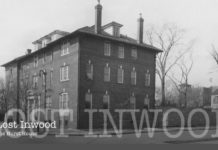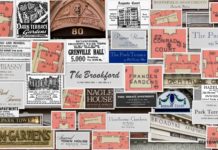
On a quiet stretch of Broadway, across from Fort Tryon Park, on the northern end of Manhattan, rests a forlorn monument to a grand automotive era.
Some say the old Packard dealership might soon be razed. Torn down. Wiped off the map.


Of course that would be a shame. The familiar old building once glimmered like a jewel box—a grand and glorious showcase for displaying the latest automobiles of the day.

Albert Kahn designed the building, with its graceful curves, in 1926. The foremost industrial architect of his generation, Kahn designed some 2,000 building over a career that spanned fifty years. He is often referred to as the “Father of Detroit architecture.” All of the above made him the go to guy for a design like 4650 Broadway.

Peel back another layer of history and a fascinating World War II tale appears. During that awful fight the building served as headquarters for the 716th Military Police Battalion.

But that was many years ago. Today developers have their sights on the aging beauty. Her fate remains undetermined.









Now, that’s something I never knew. I remember it as a Welfare (DOSS) office from the late 60’s through the ’70’s. Unlikely it could be landmarked but it would be nice if, like the Audubon Ballroom, the facade could be incorporated in the new structure.
This was the bowling alley, Manhattan Lanes, in the 1960s, right?
Yes, back in the late 50’s/ early 60′ it was Manhattan Lanes. 64 lanes! I think it was the largest bowling center in NYC. On Saturday mornings you could get rental shoes, bowl three games, get a donut and a soda-all for $1.50!
The bowling alley sounds incredible Would love to see photos. Did find this article describing Manhattan Lanes. They had a nursery and a closed circuit TV so mothers could watch the children at play through the monitors!!
https://timesmachine.nytimes.com/timesmachine/1958/09/02/91405377.pdf?pdf_redirect=true&ip=0
Bldg was a Lincoln /Mercury dealership and during WWII it was a US ARMY motor pool
My stickball field was between Sickles and Ellwood Streets on Sherman Avenue in front of this building. During WW2 the Army personnel made Carl Knutzen a millionaire. Carol owned the Park View Tavern directly across Sherman Avenue from the building entrance. After the War the building became the Pilot Garage. If you hit a Spaldeen (Spalding pronounced NY) ball on the roof of the garage it was a foul ball and you snuck into the building and went up on the roof to get the ball. Players were rated by how many city sewers they could hit on a fly ball. There was a local bookie who took action on our games. Almost every street in Inwood had a team. We booked our own games without adult involvement. The Police did not like us playing in a busy street and were always looking to take our bats. However, we had younger kids as lookouts watching for the Cops to alert us they were coming. The players were 9 to 12 years. The lookouts were 6 to 9. We promised to let them play if they were good lookouts. !
My dad Alan Trei, grew up on Sickles and could have been one of those kids. Born in 1932.